Formula One: 1986 Portuguese Grand Prix
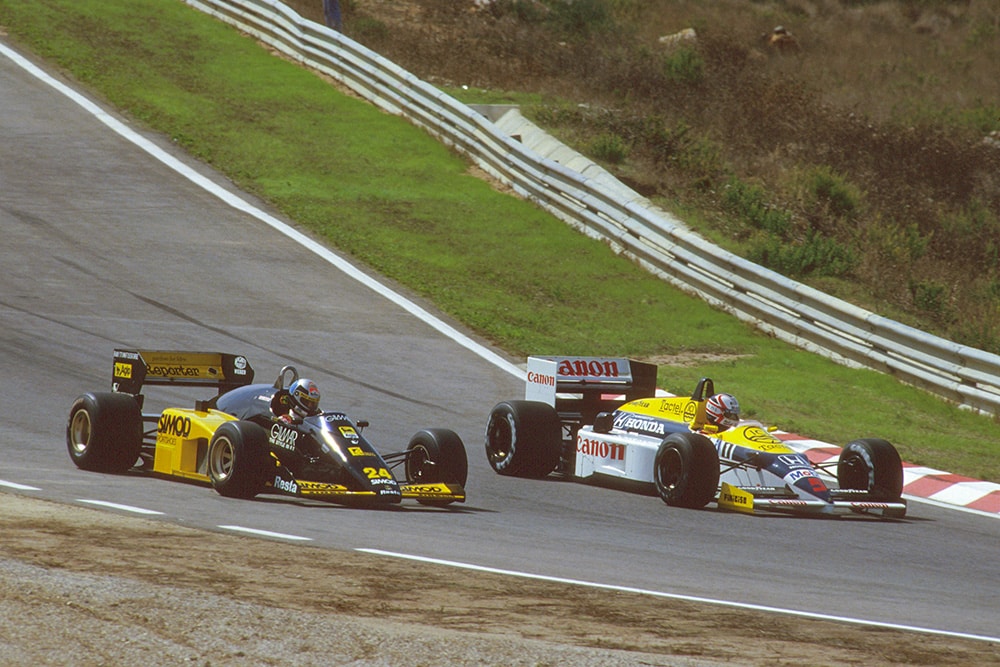
Nigel Mansell in aWilliams FW11 Honda laps Alessandro Nannini driving a Minardi M185B Motori Moderni.
© Motorsport Images
In sight of Sintra
The Autodrome of Estoril lies a few miles north of the fashionable Portuguese watering hole and on the way to the town of Sintra. If it hadn’t been for an unfortunate accident in a rally earlier this year, I doubt if the racing fraternity would have heard of Sintra. Certainly very few of them penetrate away from the Autodrome and explore the surrounding countryside, but having done so I became acutely aware that I was in rally country and among very poor people, many of them living in wooden shacks in which you would not keep a lawnmower. What they must think when the razz-ma-razz and unruliness of a rally invades their humble patch I cannot think. The Autodrome, Estoril and the coast-line of Portugal caters for the “beautiful people” and the “fashionable set” and the noise and confusion of a Formula One race was reasonably contained within its own specified area.
In years to come when we look in the Golden Book of Grand Prix racing and see the result of the 1986 Portuguese Grand Prix we shall be able to say without fear or favour, that “Nigel Mansell did a super job of work that day”. The results will read: 1st. Mansell, 2nd. Prost, 3rd. Piquet, and 4th. Senna. It probably will not say that he beat Senna to the first corner, and that in itself is something of which to be proud, nor will it say that he led from start to finish of the 70 lap race, untroubled by the trio of “heavies” in his wake, and what is more, he had enough lead by lap 34 to stop for a new set of tyres and rejoin the race still in the lead. Such was his confidence in the Williarns-Honda and its engine fuel management system, that he could keep hammering on and he set a new lap record on lap 53.
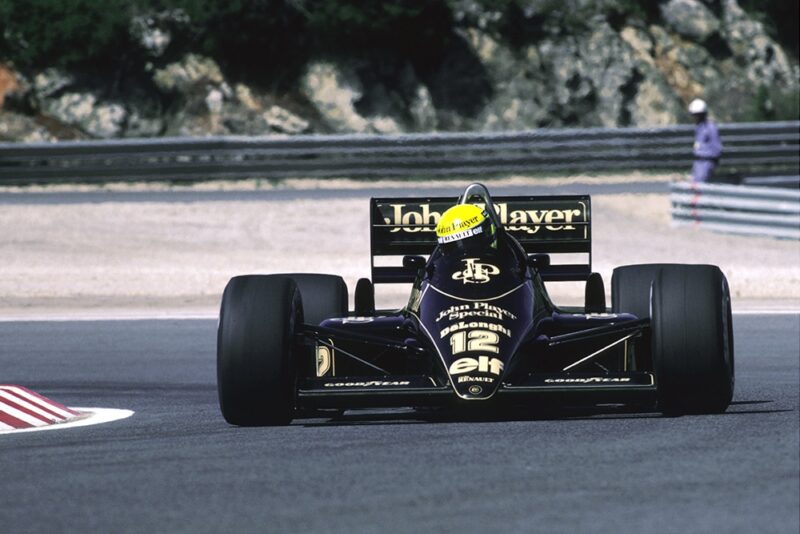
Ayrton Senna in his Lotus 98T finished in 4th place.
© Motorsport Images
After the race he said that while he was on the starting grid he kept his eyes on the glowing filament in the red light, blanking the green from his thoughts, and the moment he saw the red filament go dim on its way out, he took off. One or two people in the pits sucked their teeth and held their breath, wondering if he was going to be challenged to have jumped the start, but even if he did, it could never be proved, so fine was the line and so perfect his judgement. For as long as I have been watching motor racing I have seen people make these perfect starts, and though the rear wheels might be spinning before the current has travelled along the green filament, the front wheels move just as it glows. Perfection it is called. Mansell has been racing for a long time, but at last he seems to be learning, and some of his performances this season have been memorable. Portugal was one ot them. As he barrelled into the first corner, well clear of Senna, you could somehow sense that it was all over; he was clearly right on form and went through that long fast downhill right hand bend without a waver, obviously intending to stay out in front; head down and the power hard on, and that Honda engine lets you know when the driver is really using it. Senna with the Lotus-Renault in race trim could do nothing about the flying Mansell, but characteristically never gave up. He was still hard at it in second place as they started the seventieth lap, his engine management read-out telling him he still had enough fuel for 1-1/2 laps (it was actually reading 1.4). Half way round the Renault engine spluttered and died, and Prost and Piquet went by. Lotus and/or Renault had let him down and a certain 2nd place was lost. Although he coaxed the car round to the end of the lap he was classified as being 1 lap behind the winner.
At the German Grand Prix it had been Prost who suffered the indignity of running out of fuel and losing a certain 3rd place, this time it was Senna’s problem. It is worth thinking about that neither Mansell nor Piquet have ever suffered fuel consumption problems: the Japanese seem to have got the problem well sorted out. Piquet’s problern was a simple one, it was Ayrton Senna. The Lotus driver led the Williams driver away from the start, with the effervescent Berger between them, and even when Berger had gone, Piquet could do nothing about Senna, and you can be sure that Senna didn’t give an inch, nor did he make a single mistake. The way he took advantage of slower cars when he lapped them, to make Piquet work even harder, was a fine exhibition of track-craft; remarkable for a comparatively new driver. In the closing laps Piquet was trying as hard as his brakes would allow and got caught out on one slow hairpin and spun, losing third place to Prost, but regaining it when Senna ran dry on the last lap.
Although Prost had never featured among the front-runners he never lost touch with them. He was fifth on the opening lap and ran at a known pace commensurate with fuel consumption. It was one of those clockwork-like performances, always in touch with those in front of him but never a serious threat. While Piquet was trying to get by Senna you felt that Prost was staying at a discrete distance, ready for anything to happen. His second place at the finish was a typical Prost performance. The only time you were aware that he was always in the picture was during the tyre-stops around half-distance, when he moved up into second place for a couple of laps, until he made his own stop. That sort of thing is a sure sign that a driver is well on the pace and not getting left behind. Of his fiery little team-mate “Keke” Rosberg there is not much to say, except that he is approaching his last race, having announced that he is retiring at the end of the season. He never got higher than 5th and came to a sudden stop in the first corner when the Porsche engine blew upon lap 42. One mark that he did leave was the colour of his car. which was changed on the morning of the race from the usual bright red and white, to pale yellow and white, all to do with a new marketing strategy by the cigarette firm who sponsor the McLaren team.
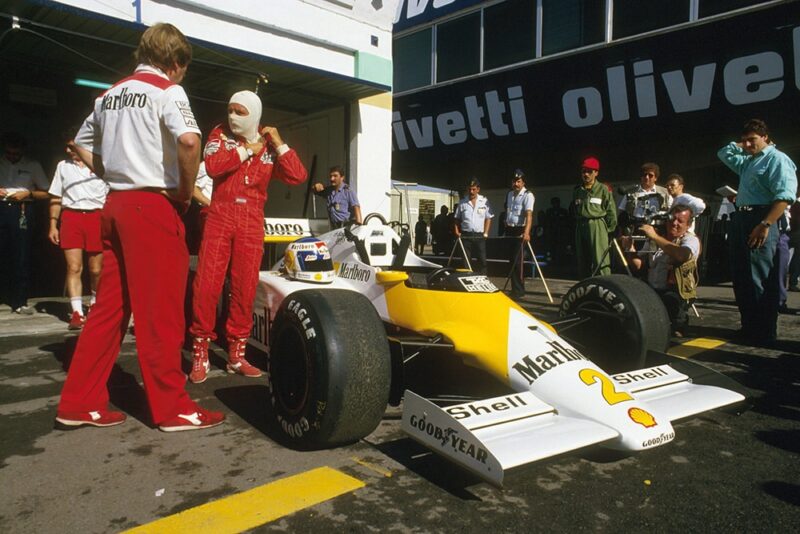
Keke Rosberg and his McLaren MP4/2C TAG Porsche in the pits.
© Motorsport Images
Among the lesser lights it was good to see Johnny Dumfries have a good race. As number two “filler” to Senna and Team Lotus the Scottish Earl has had a pretty rough season, which he has handled with equanimity and poise, suffering frustration with commendable dignity. This time there were no problems and he drove a good race, mixing it with the likes of Warwick and Tambay, and thoroughly enjoying himself. He finished 9th, losing two laps to the flying Mansell. The Brabham team continues to not cover itself with glory, the very flat and low BT55 cars still being very fast in a straight line, but losing out on lap times. Presumably it is due to a lack of cornering performance, braking or acceleration, but of course, it could just be due to the ability of the drivers. I remember a similar situation with Team Lotus, and got knocked down for my trouble in saying so. Very few drivers are prepared to admit that they are not 100% and most of them really believe they are 100%, but what they overlook is that perhaps the bunch of hard-chargers who do all the winning are 110%! The Ferrari team are in a similar situation, Alboreto and Johansson are both good drivers, but I would not put them in my list of ‘natural winners’ or even ‘natural leaders’.
At the finishing line at Estoril was a Longines speed trap and the Ferraris were well up the maximum speed list, but not so well up on lap times. On Saturday afternoon in qualifying Fabi recorded 201.5 mph in his Benetton, followed by Johansson at 197.9 mph in his Ferrari and third was Warwick with his BMW powered Brabham at 197.1 mph, followed by Senna’s Lotus-Renault at 196.9 mph. The ‘also-rans’ at the back of the grid were struggling to reach 185 mph, which gives you a sense of proportion. Most of us would be very impressed to achieve 185 mph anywhere, but that speed at the finishing line at Estoril would just get you onto the back of the grid, and within twenty laps in the race you would be lapped by the leader. Speed may be relative, but I find it fascinating and interesting. Some people were almost aghast at over 200 mph being reached down the slight incline, but they over-looked the fact that it was eighteen months since we were at Estoril, and these days Research & Development on engines is at a higher rate than it has ever been in the history of Grand Prix racing. In April 1985 the fastest car was Piquet’s Brabham BT54 at 194 mph. A lot of people want to ban turbocharging and stifle engine development, which is a pity, for right now the engine scene is fascinating.
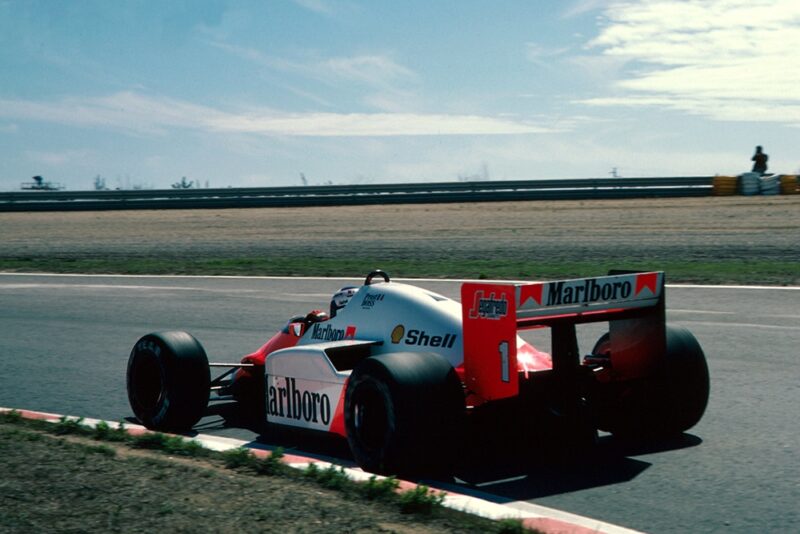
Alain Prost incise McLaren TAG MP4/2C finished in 2nd place.
© Motorsport Images
In the race the Ferraris were near the front. but not near enough to cause any worries to the Williams, Lotus, McLaren, or Benetton runners, but two-thirds of the way through the race Johansson had an unfortunate “coming together” with Berger. The Benettons were running through non-stop on their Pirelli tyres, as indeed did Arnoux in the Ligier, and when Johansson stopped for new Goodyears it put him back behind Berger when he rejoined the race. He was catching him steadily and by the end of lap 44 he was on the tail of the Benetton.
Down the pit straight he got in front and was actually leading as they arrived at the braking point for the downhill right-hander on lap 45. The Ferrari was on the outside and on the perfect racing line into the bend and was committed when Berger decided to dive down the inside. The inevitable happened just about on the apex of the corner and the Benetton hit the Ferrari, side by side. Both cars spun, the Ferrari going remarkably high into the air, and they ended up well off the track in the large loose-surface run-off area. Berger had stalled his BMW engine and that was that, but Johansson still had his Ferrari engine running and could be seen driving round in a cloud of dust looking for the way out and back onto the track. There was slight damage to the right side of the Ferrari, but nothing too serious and he was soon back on his pace, while a thoughtful Berger walked back to the pits. It so happened that I was standing on the inside of the corner right opposite their point of contact, and while my reaction to Berger was “silly boy” I would not necessarily give him a black mark for his action.
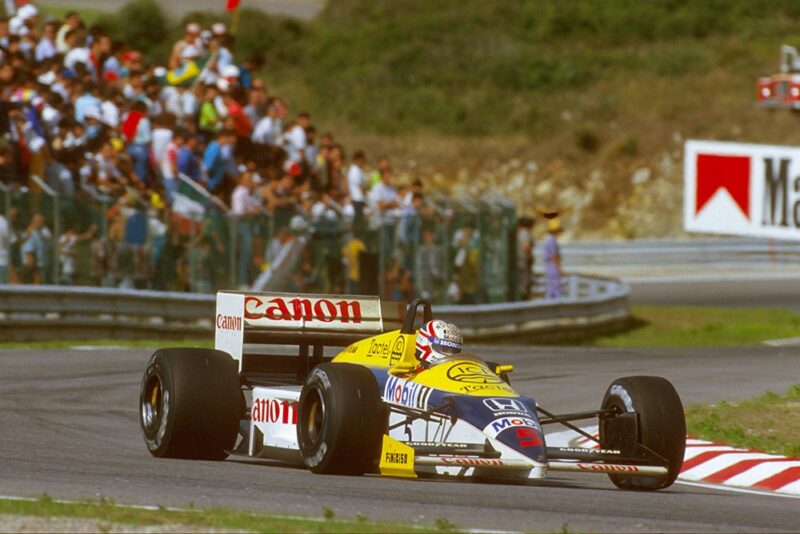
Nigel Mansell at the wheel of his Williams FW11 Honda.
© Motorsport Images
After all, they were racing for sixth place, and both drivers have a natural ability to get on with the job, and not whinge and moan. It was just unfortunate, but at least justice prevailed and Johansson was able to continue and finish sixth. Looking at his lap times after the race made interesting reading. On lap 44 he recorded 1 min 24.6 secs, on lap 45 the time was 1 min 47.0 secs, and lap 46 his time was 1 min 24.8 secs, followed by two laps at 1 min 23.8 secs, then 1 min 22.6 secs and on lap 50 his fastest lap in the race at 1 min 22.3 secs. The accident, spin, and recovery on lap 45 cost him 22.4 secs, during which time Alboreto went by into sixth place. Certainly Johansson was niggled, but not so much that it affected his driving, in fact it was the stimulus to go just that little bit faster to try and regain his rightful place. There have been drivers in a similar situation who have gone off in a fury and then crashed, while others have given up and gone slower, or even suffered fright and slowed up. Johansson’s reaction to the whole incident was most interesting, and is just one of those small things that add up to someone being a good “racer”.
Taken all round, the 1986 Portuguese Grand Prix was a good event, enjoyable and full of interest, and the Estoril Autodrome and the general surroundings make it one of the happier events of the year. When the first Grand Prix was held in 1984 everyone enjoyed it except the organisers, for there were so few spectators you could actually count them. The following year it poured with rain and the spectators were even less. This year it was comfortably warm and quite a good crowd turned up, even on Saturday for practice and a lot of spectators crossed over from Spain by the look of the licence plates in the car parks. Back in 1985 we had misgivings about the future of the Portuguese Grand Prix, but now things look much brighter and hopefully it will go from strength to strength. It deserves to, for it is a meeting with very few problems and while the circuit is not Grand in the Grand Prix style, it is not boring and dull like some Autodromes I could mention. If it can maintain its Autumn date it will be a good thing. — DSJ
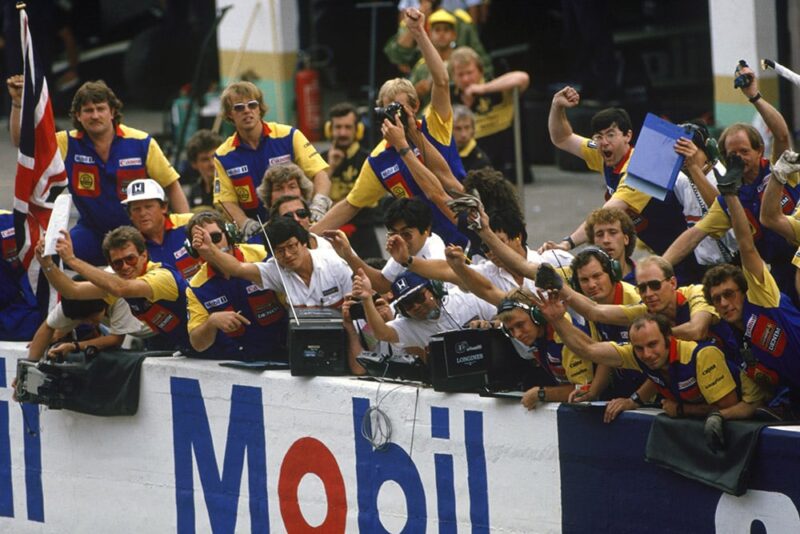
The Williams team celebrate Nigel Mansell’s the victory on the pit wall.
© Motorsport Images
Results (top five) –Portuguese Grand Prix — Autodromo Estoril — September 21
70 laps of 4.350 km circuit, 304.500 kilometres (189.207 miles)
1. Nigel Mansell (Williams FW11 – Honda V6) — 1hr 37min 21.900sec
2. Alain Prost (McLaren MP4/2C – Porsche V6 — 1hr 37min 40.672sec
3. Nelson Piquet (Williams FW11 – Honda V6) — 1hr 38min 11.174sec
4. Ayrton Senna (Lotus 98T- Renault V6) — 1 lap behind — out of fuel
5. Michele Alboreto (Ferrari F1/86 – Ferrari V6) — 1 lap behind
Conditions: Warm
Fastest lap: N. Mansell — 1m 20.943sec on lap 53, av 193.469 kph (120.216mph). New record.
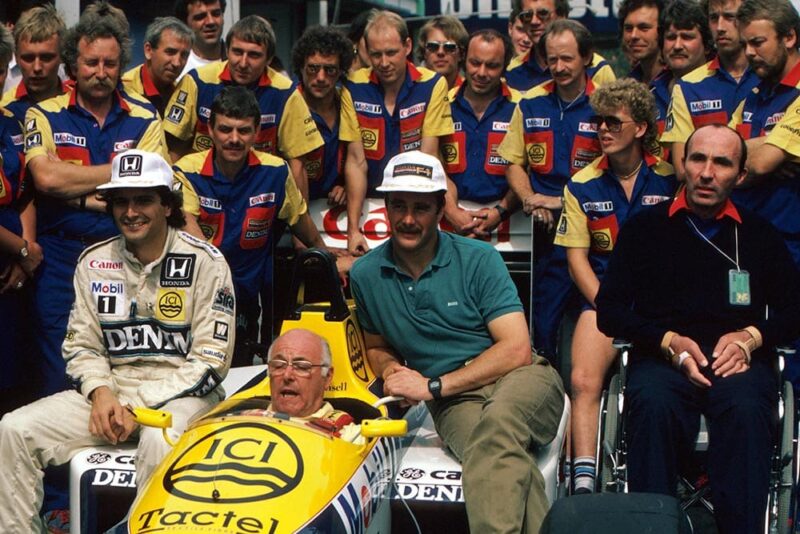
BBC TV commentator Murray Walker in the Williams FW11 sits with the regular drivers Nelson Piquet (left) and Nigel Mansell. Team Owner Frank Williams sits to the right.
© Motorsport Images
